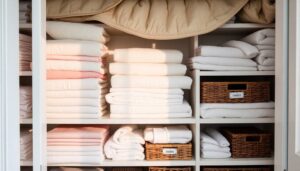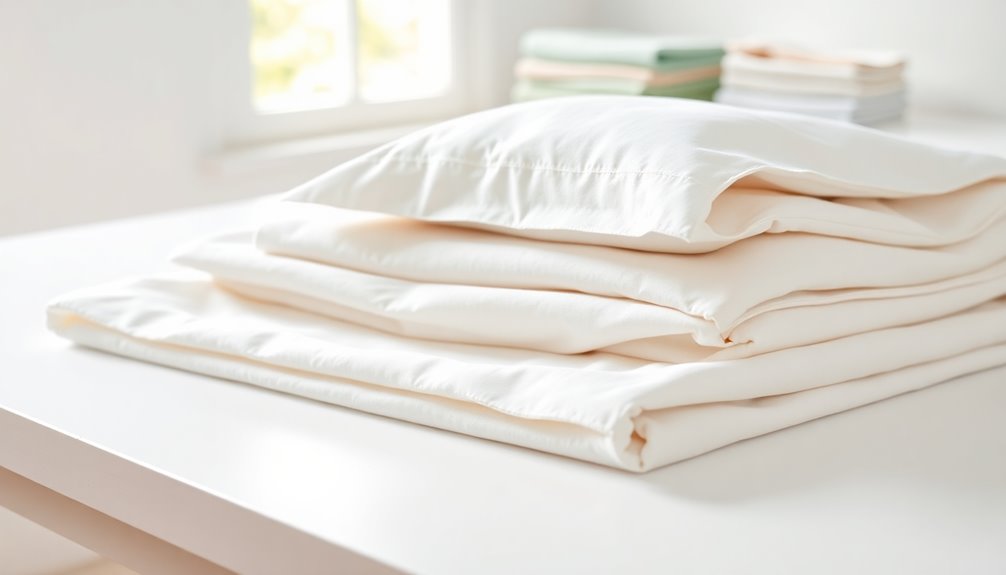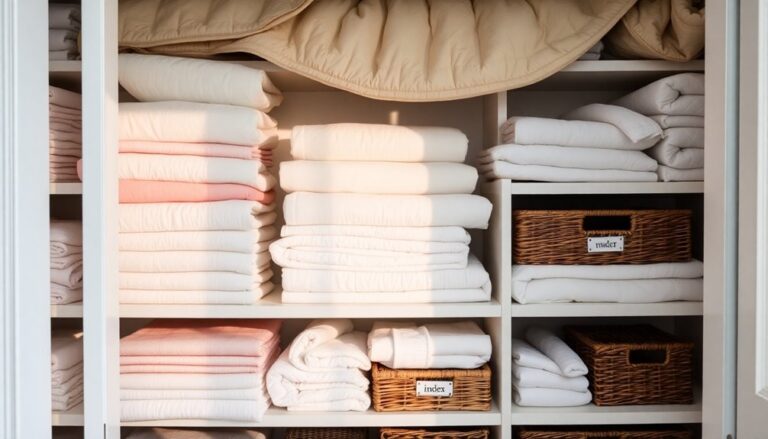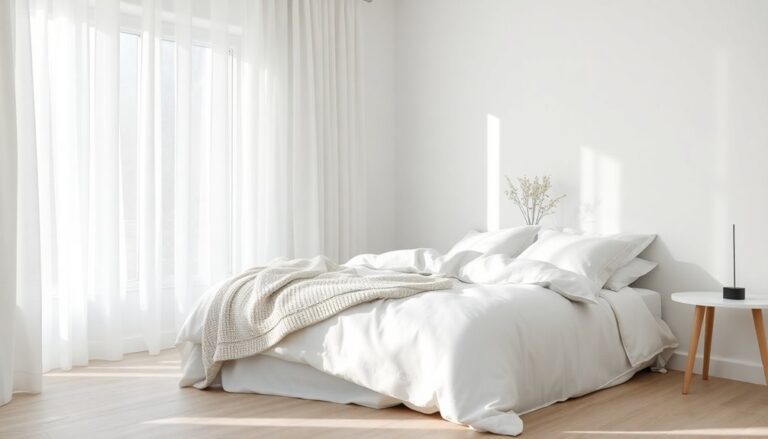Folding linens like a pro involves a systematic approach to guarantee everything looks neat and organized. Start by sorting linens by type and size. For flat sheets, fold them in half lengthwise and then into thirds. Fitted sheets require tucking corners for a tidy shape before folding. Use a clean, flat surface and proper storage techniques, like breathable bags. With these tips, anyone can improve their linen organization skills. There's even more to discover to perfect the process.
Article Highlights
- Sort linens by type and size before folding to streamline the process and ensure efficiency.
- Iron wrinkled linens to enhance appearance and make folding easier.
- Use a clean, flat surface to lay out linens for meticulous folding.
- Master the technique of folding fitted sheets by tucking corners for a neat appearance.
- Store linens in breathable containers, organized by type and season, to maintain freshness.
The Essential Linens You Need to Organize
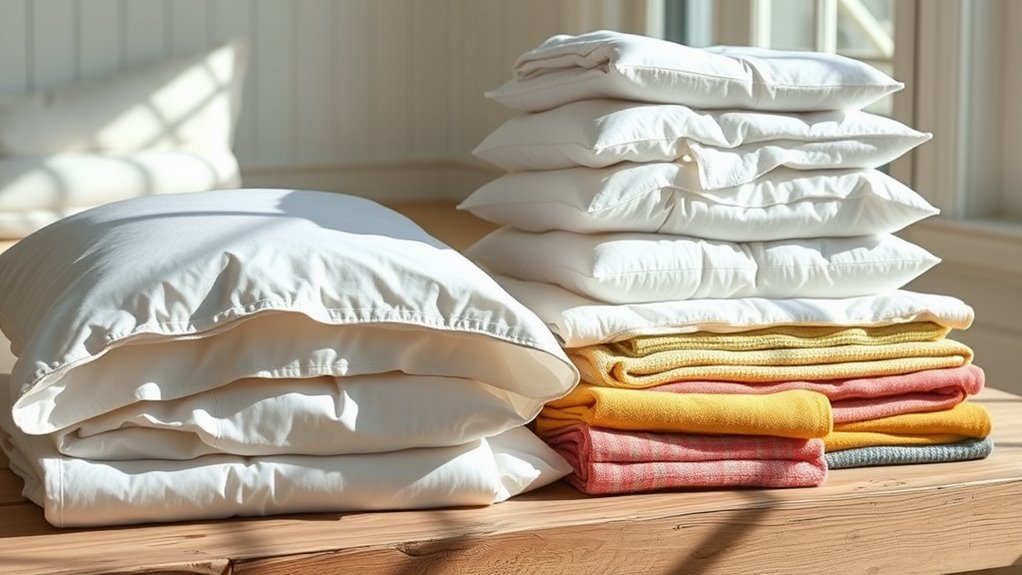
In regards to organizing linens, having the right fundamentals makes all the difference. To effectively manage your collection, one must consider various linen types and materials. Key items include bed sheets, pillowcases, tablecloths, and towels. Each category offers unique benefits: cotton sheets are breathable, whereas microfiber towels are highly absorbent. Linen materials like cotton and bamboo provide comfort and durability, making them popular choices for many households. It's vital to categorize linens based on their use and material, as this simplifies the organization process. By comprehending the key linen types, individuals can create a more efficient storage solution that saves time during laundry days. Proper organization not only improves aesthetics but likewise prolongs the lifespan of these key household items.
Preparing Your Linens for Folding
Before plunging into the folding process, it is vital to prepare your linens properly. A well-organized laundry routine sets the foundation for effective linen care. Start by sorting your linens based on type and size, verifying they're clean and completely dry. This prevents mildew and maintains freshness. Check for any stains or damage; addressing these issues before folding saves time later. Ironing wrinkled linens can additionally improve their appearance, making folding much easier. Finally, designate a clean, flat surface for folding to keep everything tidy. By taking these simple steps, one can guarantee that the folding process is efficient and enjoyable, ultimately leading to neatly organized linens ready for use.
Mastering the Flat Sheet Folding Technique
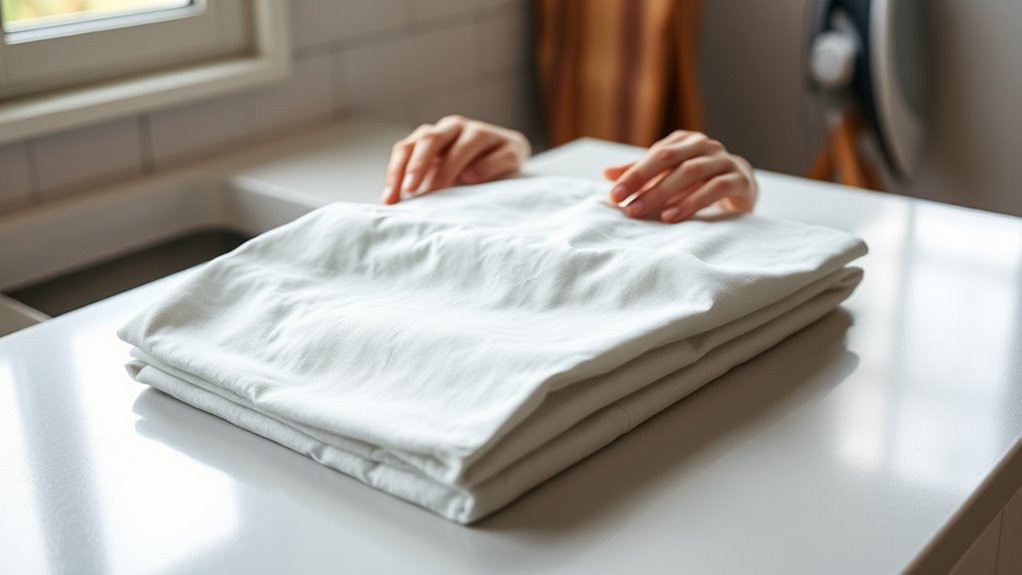
In terms of perfecting the flat sheet folding technique, preparation is key. Setting up a tidy workspace and following the right folding method steps can make all the difference. With a few final touches, anyone can achieve a neatly stored flat sheet.
Preparing Your Workspace
Although perfecting the flat sheet folding technique requires practice, preparing your workspace can make the process much smoother. A well-organized workspace is crucial for effective folding techniques. Here are five items to take into account for ideal workspace organization:
- A flat, clean surface to fold on
- Sufficient lighting to see creases clearly
- A measuring tape for precise folds
- A comfortable height to reduce strain
- Storage solutions for easy access to linens
Folding Method Steps
Acquiring proficiency in the flat sheet folding technique involves a series of straightforward steps that anyone can follow. Perfecting these folding techniques can greatly improve linen organization, making your storage more efficient and visually appealing.
| Step | Description |
|---|---|
| Step 1 | Lay the sheet flat on a clean surface. |
| Step 2 | Fold the sheet in half lengthwise, aligning edges. |
| Step 3 | Fold it in thirds or quarters, depending on size. |
Final Touches and Storage
After perfecting the folding technique, the final touches play a significant role in ensuring that your linens both look neat and remain organized. To improve linen presentation, consider the following tips:
- Use matching storage containers to maintain a cohesive look.
- Label drawers or shelves for easy access and organization.
- Store linens by size, keeping sets together to simplify retrieval.
- Add a scented sachet to the storage area for a pleasant aroma.
- Regularly check for wear and replace damaged items without delay.
These final touches not only enhance the appearance of your linens but also contribute to a more efficient storage system. With a little effort, anyone can achieve a professional level of linen presentation that impresses guests and simplifies laundry day.
Folding Fitted Sheets With Ease
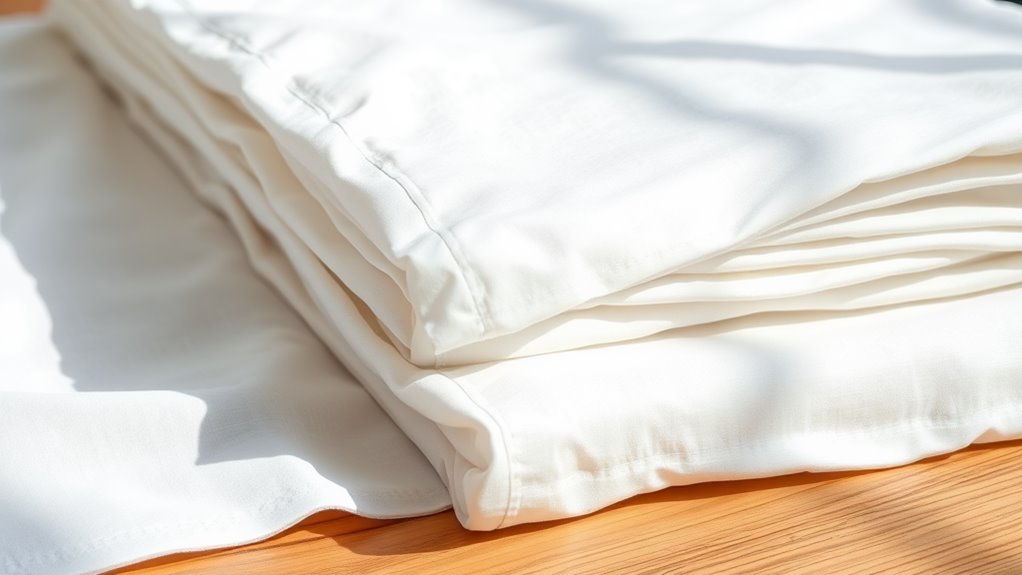
Folding fitted sheets can often feel like an intimidating task, but with a few simple steps, anyone can master it. First, hold the sheet by its corners, ensuring the elastic is facing you. Next, tuck one corner into the opposite corner, then fold in the next two corners, creating a neat shape. This fitted sheet technique helps streamline the process. To finish, lay the sheet flat on a surface and fold it into thirds, smoothing out any wrinkles. These sheet folding hacks not only simplify the task but also result in a tidy appearance. With practice, folding fitted sheets will become a quick and easy part of linen care, leaving you with more time for other household chores.
Pillowcase Folding Tips for a Polished Look
Though it may seem simple, perfecting the art of pillowcase folding can improve the overall look of your linen closet. By following a few straightforward tips, anyone can achieve a polished appearance for their pillowcases, regardless of the pillowcase sizes or patterns.
- Choose a flat surface for folding.
- Lay the pillowcase inside out for neatness.
- Align the edges carefully to avoid creases.
- Fold into thirds for a compact fit.
- Arrange by size and pattern for easy access.
These techniques not just create a visually appealing display but also guarantee that your linens remain wrinkle-free. Mastering pillowcase folding will make a noticeable difference, reflecting a sense of organization and care in your home.
Storing Your Linens: Best Practices
Properly storing linens can make a significant difference in their longevity and appearance. For ideal linen care, it is crucial to choose the right storage solutions. Start by ensuring linens are completely clean and dry to prevent mildew. Use breathable fabric bags or cotton sheets to wrap delicate items, which helps maintain their freshness. Avoid plastic containers, as they can trap moisture and lead to mold growth. Storing linens in a cool, dark place protects them from fading and deterioration. It is also advantageous to organize by type and season, making it easier to find what's needed. By employing these best practices, anyone can preserve their linens and keep them looking new for years to come.
Maintaining Your Linen Closet Organization
An organized linen closet can make a world of difference in how easily one can find what they need. By implementing effective closet organization strategies, maintaining this order becomes simple. Here are some crucial linen maintenance tips to keep in mind:
- Sort linens by type (sheets, towels, etc.)
- Use labeled bins or baskets for easy identification
- Rotate older items to the front for use
- Regularly check for any damaged or worn linens
- Keep a small inventory list to track quantities
Creative Ways to Use Extra Linen Space
When extra space in a linen closet becomes available, it opens up a world of creative possibilities for maximizing utility. One innovative approach is to transform linens into beautiful linen art. This can include framing embroidered pieces or creating decorative wall hangings from vintage tablecloths. Another idea is to dedicate a section of the closet to linen crafts, where scraps can be stored for DIY projects. Think about storing fabric leftovers for quilting or making unique pillow covers. Furthermore, using baskets or bins can help organize these crafts during keeping the closet neat. By thinking outside the box, anyone can utilize extra linen space for functional and artistic purposes, turning a simple closet into a creative haven.
Frequently Asked Questions
How Often Should I Wash My Linens?
In terms of washing frequency, it's typically advised to wash linens every one to two weeks. This aids in maintaining cleanliness and hygiene. For those with allergies or sensitive skin, more frequent washing might be essential. Proper linen care likewise involves checking for stains and addressing them without delay. By following these guidelines, individuals can guarantee their linens remain fresh and comfortable, contributing to a healthier sleeping environment.
What Materials Are Best for Linens?
In the kingdom of textiles, two noble materials reign supreme: cotton and polyester. Cotton, with its breathability and softness, makes for a cozy haven, whereas polyester boasts durability and resistance to wrinkles. As it relates to linen care, each fabric demands its unique touch; cotton thrives with gentle washing, whereas polyester requires less attention. In the end, the choice between cotton and polyester depends on one's desire for comfort versus convenience, guiding the path to linen bliss.
Can I Use Fabric Softener on My Linens?
When considering whether to use fabric softener on linens, one should weigh the benefits against potential drawbacks. Fabric softener can make linens feel softer and reduce static cling, enhancing comfort. Nevertheless, some alternatives like vinegar or baking soda can achieve similar results without leaving residues. It's important to check care labels, as certain fabrics may not respond well to softeners. Ultimately, comprehending each option helps in maintaining linens effectively.
How Do I Remove Wrinkles From Linens?
When it relates to removing wrinkles from linens, there are effective methods to contemplate. One popular approach is steam removal, which involves using a steamer or hanging the linens in a bathroom as a hot shower runs. For those seeking wrinkle-free tips, they can try washing linens in warm water and swiftly removing them from the dryer. Additionally, storing linens neatly can help minimize future wrinkles, making laundry day easier.
What Is the Best Way to Store Seasonal Linens?
Storing seasonal linens effectively can help prolong their lifespan; in fact, improper storage can reduce fabric quality by up to 50%. To optimize linen organization, she should wash and completely dry the linens before folding. Then, using breathable cotton or linen storage bags can protect against dust and pests. Labeling each bag by season guarantees easy access, allowing her to enjoy her linens year after year without worrying about damage or wrinkles.



